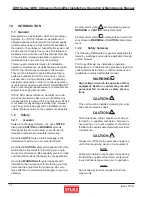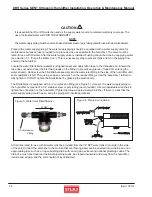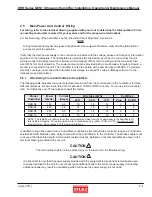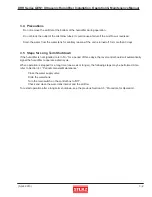
(April, 2013)
DRH Series GEN1 Ultrasonic Humidifi er Installation, Operation & Maintenance Manual
1.6.12 Solid State Relay
The 48 VDC operating voltage for the Ultrasonic
Nebulizer Units is switched on and off by a solid state
DC relay controlled by the Level Controller.
1.6.13 Level Controller
The Level Controller is a microprocessor based
device located in the electric box that receives inputs
from sensors and other inputs and in turn controls the
valves, fan and Ultrasonic Nebulizer Units. It consists
of a DC-DC power supply to convert the 48VDC
to 24VDC for the fans and solenoids and a further
reduction to 5VDC for the microprocessor, sensors,
power switches and either a Modbus interface to
communicate with the Ultra-Series Controller or
a simple standalone input interface depending on
which model humidifi er was purchased. The 48
VDC must be present at all times to allow the Level
Controller microprocessor to monitor the inputs and
control the outputs.
The microprocessor monitors the on/off command
from either the Modbus or the input dry contact
(depending on which model was purchased). If
commanded on, the microprocessor checks the Low
Water Float Switch and the High Water Float Switch.
If the water is too low, the microprocessor turns on
the Water Fill Valve Solenoid and monitors the Float
Switches. When the water level is above the low
water level, the fan is turned on. When the water
level is above the high water level, the Water Fill
Valve Solenoid is turned off and the Solid State Relay
is turned on. When the water level falls below the
high water level, the microprocessor turns the Water
Fill Valve Solenoid on again to maintain optimal
water level. When the on/off command is removed,
the Solid State Relay is turned off and, after a few
seconds time delay to eliminate the remaining mist
from the humidifi er, the Fan is turned off.
Proportional control is accomplished by the
microprocessor monitoring the proportional signal
from the Modbus or proportional input (depending on
which model was purchased). When the proportional
signal is greater than 10% of the maximum input, the
microprocessor will turn the Solid State Relay on and
off in a pulse-width modulation control. The period
of the pulse width is 1 second. For 10% control, the
Solid State Relay is turned on for 0.1 second and off
for 0.9 second. The on time increases as the input
approaches 100%. At 100%, the Solid State Relay is
on continuously.
Safety control is built into the microprocessor. The
voltage applied to the transducer affects the amount
of mist produced. Too high a voltage can cause
damage to the transducer and too low a voltage
prevents mist from being formed. The microprocessor
monitors the 48 VDC to be within a range of voltages.
If the voltage is out of range, the microprocessor will
not energize the Solid State Relay.
If the temperature of the tank rises too high, the
microprocessor turns off the Solid State Relay.
If the temperature approaches freezing, the
microprocessor turns off the Solid State Relay and
the fan, and then drains the tank to prevent damage
from freezing water. When the temperature returns to
a safe level, normal operation is resumed.
A low level alarm is annunciated when the
microprocessor sees the Low Level Float Switch
indicate low water after the tank has been fi lled. A
fi ll alarm is annunciated when the High Water Float
Switch does not indicate the water level has been
achieved after a predetermined amount of time. A
transducer alarm is annunciated if the transducers
have been energized and no water is used in a
predetermined time (indicating no transducer is
functioning). For the Modbus version of the Level
Controller, failure to receive commands on the
Modbus within a predetermined amount of time will
annunciate a communications alarm.
The Level Controller has an LED that displays, via
blinking, any alarm condition that occurred after
power up. Each alarm is associated with a number of
blinks, followed by a pause, and then the next alarm
is displayed. To view the LED, the Mist Guide Cover
must be removed and the electrical access cover
removed. The LED blink pattern for each alarm is:
Number
of Blinks
Alarm Condition
1
Low Voltage
2
High Voltage
3
Freeze
4
High Temperature
5
Low Water
6
Fill Alarm
7
Communications
8
Transducer
1-6
























